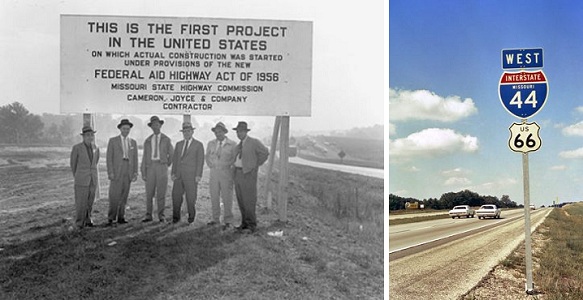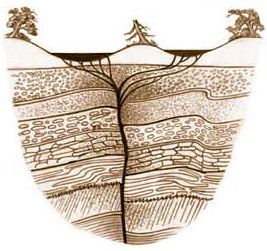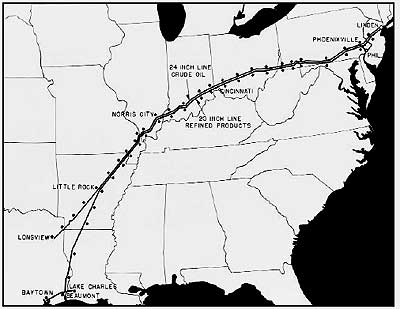August 1, 1872 – Iron Pipeline delivers Pennsylvania Natural Gas –
The first recorded large-scale delivery of natural gas by pipeline began when gas was sent to more than 250 residential and commercial customers in Titusville, Pennsylvania, home of America’s first oil well, drilled in 1859. The two-inch iron pipeline carried the natural gas five miles from a well producing four million cubic feet of natural gas a day.
The mayor of Titusville and other investors had formed the Keystone Gas & Water Company to construct the pipeline for delivering “the most powerful and voluminous gas well on record.”
The historic gas well produced into the 1880s, according to the Drake Well Museum and Park in Titusville.
August 2, 1956 – Missouri builds First U.S. Interstate Highway
Missouri became the first state to award a contract with interstate construction funding authorized two months earlier by the Federal-Aid Highway Act. The highway commission agreed to begin work on part of Route 66, now Interstate 44.

Missouri launched the U.S. interstate system after “inking a deal for work on U.S. Route 66.” Today, I-44 stretches across south central Missouri and is a major corridor linking the Midwest and the West Coast.
“There is no question that the creation of the interstate highway system has been the most significant development in the history of transportation in the United States,” proclaimed the Missouri Department of Transportation.
Learn more transportation and oil history in America on the Move.
August 3, 1769 – La Brea Asphalt Pits discovered
A Spanish expedition discovered what would be called La Brea (the tar) pits on the West Coast. “We debated whether this substance, which flows melted from underneath the earth, could occasion so many earthquakes,” noted the expedition’s Franciscan friar in his diary.

Outside the Page Museum of Los Angeles, life-size replicas of several extinct mammals are featured at the Rancho La Brea in Hancock Park. Although called the “tar pits,” the pools are actually asphalt.
The friar, Juan Crespi, was the first person to use the term “bitumen” in describing these sticky pools in southern California — where crude oil has been seeping from the ground through fissures in the coastal plain sediments for more than 40,000 years. Native Americans used the substance for centuries to waterproof baskets and caulk canoes.

Pools form when crude oil seeps to the surface through fissures in the earth’s crust.
Although popularly called the tar pits, the pools at Rancho La Brea are actually asphalt — not tar, which is a by-product made by the distillation of woody materials, such as peat. Asphalt is a naturally formed substance comprised of hydrocarbon molecules (see Asphalt Paves the Way).
Learn more in Discovering the Le Brea Tar Pits.
August 3, 1942 – War brings “Big Inch” and “Little Big Inch” Pipelines
War Emergency Pipelines Inc. began construction on the “Big Inch” line — the longest petroleum pipeline project ever undertaken in the United States. Conceived to supply wartime fuel demands — and in response to U-boat attacks on oil tankers along the eastern seaboard and Gulf of Mexico, the “Big Inch” and “Little Big Inch” lines were extolled as “the most amazing government-industry cooperation ever achieved.”

The longest petroleum pipeline project ever undertaken led to construction of a 24-inch pipeline from East Texas to Illinois, and a 20-inch line as far as New York City.
With a goal of transporting 300,000 barrels of oil per day, the $95 million project called for construction of a 24-inch pipeline (Big Inch) from East Texas to Illinois, and a 20-inch line (Little Big Inch) as far as New York and Philadelphia — more than 1,200 miles (the Trans-Alaska pipeline system is 800 miles long).
Learn more in Big Inch Pipelines of WWII.
August 4, 1913 – Discovery of Oklahoma’s “Poor Man’s Field”
The Crystal Oil Company completed its Wirt Franklin No. 1 well 20 miles northwest of Ardmore, Oklahoma. The well revealed the giant Healdton field, which became known as the “poor man’s field,” because of its shallow depth and low cost of drilling. The area attracted many independent producers with limited financial backing.

The Healdton Oil Museum includes IPAA founder Wirt Franklin’s Pierce-Arrow. The museum hosts annual oil history events.
Another major oil discovery in 1919 revealed the Hewitt field, which extended oil production in a 22 mile swath across Carter County. The Greater Healdton-Hewitt oilfield produced, “an astounding 320,753,000 barrels of crude by the close of the first half of the 20th century,” noted historian Kenny Franks.
In 1929, Wirt Franklin became the first president of the then Tulsa-based Independent Petroleum Association of America (IPAA). Erle Halliburton perfected his method of cementing oil wells in the Healdton field (see Halliburton and the Healdton Oilfield).
Learn more about Oklahoma’s historic “poor man’s field” by visiting the Healdton Oil Museum.
August 4, 1977 – U.S. Department of Energy established
President Jimmy Carter signed the Department of Energy Organization Act, which established the twelfth cabinet-level department by consolidating a dozen agencies and energy-related programs of the federal government. The new department combined the Federal Energy Administration and Energy Research and Development Administration; DOE also became responsible for nuclear weapon programs and national labs. James Schlesinger was sworn in as first Secretary of Energy.
_______________________
Recommended Reading: The Big Roads: The Untold Story of the Engineers, Visionaries, and Trailblazers Who Created the American Superhighways (2012); Monsters Of Old Los Angeles – The Prehistoric Animals Of The La Brea Tar Pits
(2008); Oil: From Prospect to Pipeline
(1971); Ragtown: A History of the Greater Healdton-Hewitt Oil Field
(1989). Amazon purchases benefit the American Oil & Gas Historical Society. As an Amazon Associate, AOGHS earns a commission from qualifying purchases.
_______________________
The American Oil & Gas Historical Society (AOGHS) preserves U.S. petroleum history. Become an AOGHS annual supporting member and help maintain this energy education website and expand historical research. For more information, contact bawells@aoghs.org. Copyrihttp://homeght © 2023 Bruce A. Wells. All rights reserved.


